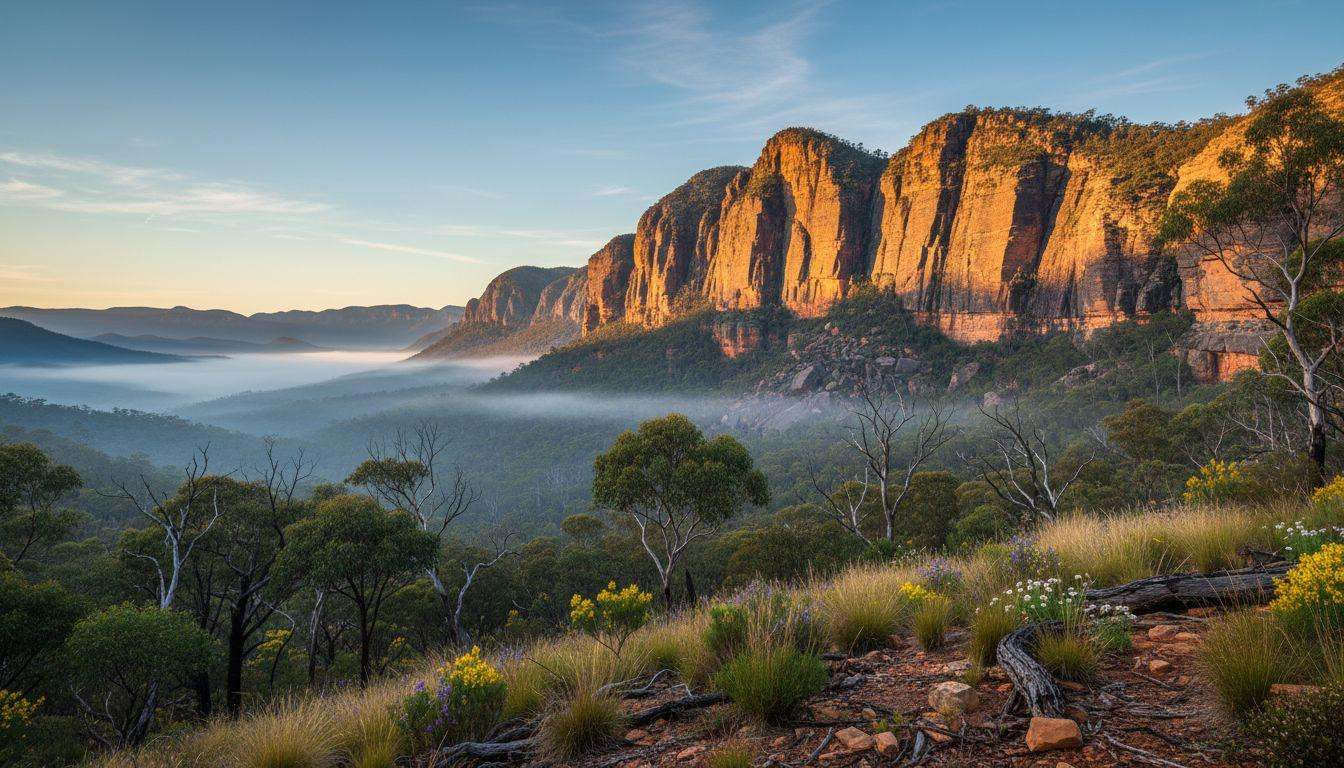Morning light strikes sandstone peaks at 6:15 AM, turning ancient mountains amber while mist rises from valleys that Aboriginal people have called Gariwerd for 20,000 years. Three hours west of Melbourne’s crowds, the Grampians guard 200+ rock art sites alongside dramatic cliff-edge lookouts where golden peaks fade into endless blue sky. This 413,210-acre sanctuary preserves Australia’s oldest continuous cultural heritage within rugged wilderness accessible to any traveler.
Where ancient mountains meet Aboriginal timelessness
The Grampians rise 162 miles west of Melbourne, their sandstone peaks glowing russet and gold against deep green valleys. The Jardwadjali people named this landscape Gariwerd long before European maps existed. Mount William stands as the highest peak at 3,829 feet while MacKenzie Falls creates Victoria’s most spectacular cascade.
The park encompasses rugged mountain ranges, forested gullies, and heritage-listed Aboriginal sites spanning millennia. Halls Gap serves as the main gateway village, while nearby towns like Dunkeld and Stawell provide additional access points. The landscape itself tells geological stories millions of years old, now protected alongside 20,000+ years of continuous human cultural expression.
Rock shelters where 20,000 years live in ochre
Five Aboriginal rock art shelters open to visitors, each revealing distinct stories painted in red ochre and white pigment against sandstone. This sanctuary where the Milky Way’s dust lanes fade into rose-gold dawn light shares the same ancient geological formations that inspired Aboriginal artists across millennia.
The sacred galleries
Ngamadjidj Shelter, the “Cave of Ghosts,” displays white-painted figures where Jardwadjali families once sheltered. Bilimina Shelter features 55 human stick figures alongside emu and kangaroo track depictions. Gulgurn Manja preserves handprints of children aged 8-12, their small palms pressed against rock 8,000-12,000 years ago.
Bunjils Shelter holds Australia’s only known rock art of the creator spirit Bunjil. The Aboriginal deity who formed land, water, trees, and animals. Manja Shelter contains over 90 hand stencils alongside animal tracks and human figures.
Standing before ancient hands
The 15-minute walk to Gulgurn Manja from Hollow Mountain Car Park leads to a rock shelf where morning light illuminates children’s handprints spanning millennia. The emotional weight of standing before these marks creates profound connection across time. This lake where morning mist rises from 705 feet of glacial water offers similar moments of ancient reverence in Victoria’s wilderness.
Where dramatic lookouts frame endless valleys
The park’s signature experiences balance challenging hikes with accessible panoramic rewards. Recent visitor surveys from 2025 show that 78% of travelers rate the combination of cultural sites and mountain vistas as “transformative.”
The Pinnacle and beyond
The Pinnacle Walk delivers Victoria’s most iconic mountain view through a 2.1-mile trail from Sundial Car Park. Water crossings, rock-hopping, and the narrow “Silent Street” canyon precede sweeping valley panoramas. Boroka Lookout and Reed Lookout provide dramatic vistas across Mt. William and Serra Ranges.
MacKenzie Falls offers wheelchair-accessible Bluff viewing or a steep one-hour trail descending to the base where water crashes over golden rock. The Balconies present dramatic rock formations perfect for sunrise photography. This canyon where a turquoise river cuts 600 feet through ancient Appalachian rock shares similar geological drama across ancient stone formations.
Spring wildflowers and wildlife encounters
Spring brings mild temperatures of 59-68°F and transforms valleys into purple, yellow, and white wildflower displays. Kangaroo mobs rest openly in valleys while echidnas, wallabies, and endemic birds create constant wildlife encounters. Lyrebirds call from forested gullies at dawn.
Where timelessness outlasts tourism trends
Unlike commercialized destinations demanding advance bookings and vehicle permits, the Grampians maintain understated accessibility despite world-class offerings. The combination of 102-mile Grampians Peaks Trail, Aboriginal cultural depth, and dramatic mountain landscapes rivals international destinations yet receives a fraction of crowds compared to coastal attractions.
Recent trail reopenings in November 2025 and Brambuk Cultural Centre expansions demonstrate ongoing commitment to respectful heritage preservation. The park’s spring wildflower displays and diverse difficulty levels create genuine accessibility without sacrificing authentic wilderness character. This village where boatwomen row with their feet between limestone walls and emerald water exemplifies similar living heritage preserved through respectful tourism practices.
Your questions about Grampians National Park answered
When should I visit and what does it cost?
Spring offers ideal weather with temperatures of 59-68°F, spectacular wildflower displays, and lower crowds than summer. Accommodation in Halls Gap ranges $65-245+ nightly depending on season and style. Most walking tracks and lookouts require only park entry fees. Full-day guided tours from Melbourne provide transport and interpretation.
How do I respectfully experience Aboriginal heritage?
Visit Brambuk National Park and Cultural Centre at 277 Grampians Road, Halls Gap, open 9am-4pm daily for proper cultural context before visiting rock art sites. The five open shelters feature interpretive signage. Photography is permitted but treat sites with reverence. These represent living cultural heritage spanning 20,000+ years.
How does this compare to other Australian parks?
The Grampians offer cultural depth absent from purely scenic destinations like the Great Ocean Road, combined with mountain landscapes rivaling Tasmania’s wilderness. Unlike Uluru’s 500,000 annual visitors and strict protocols, the Grampians provide intimate Aboriginal heritage encounters within accessible hiking infrastructure. The 162-mile distance from Melbourne creates genuine escape without requiring multi-day journeys to remote regions.
Dawn light fades from The Pinnacle’s edge as valley mist clears to reveal ranges stretching toward blue infinity. Somewhere below, ancient handprints rest silent in stone shelters, waiting for the next person willing to stand still long enough to feel 20,000 years breathing through ochre and rock.
